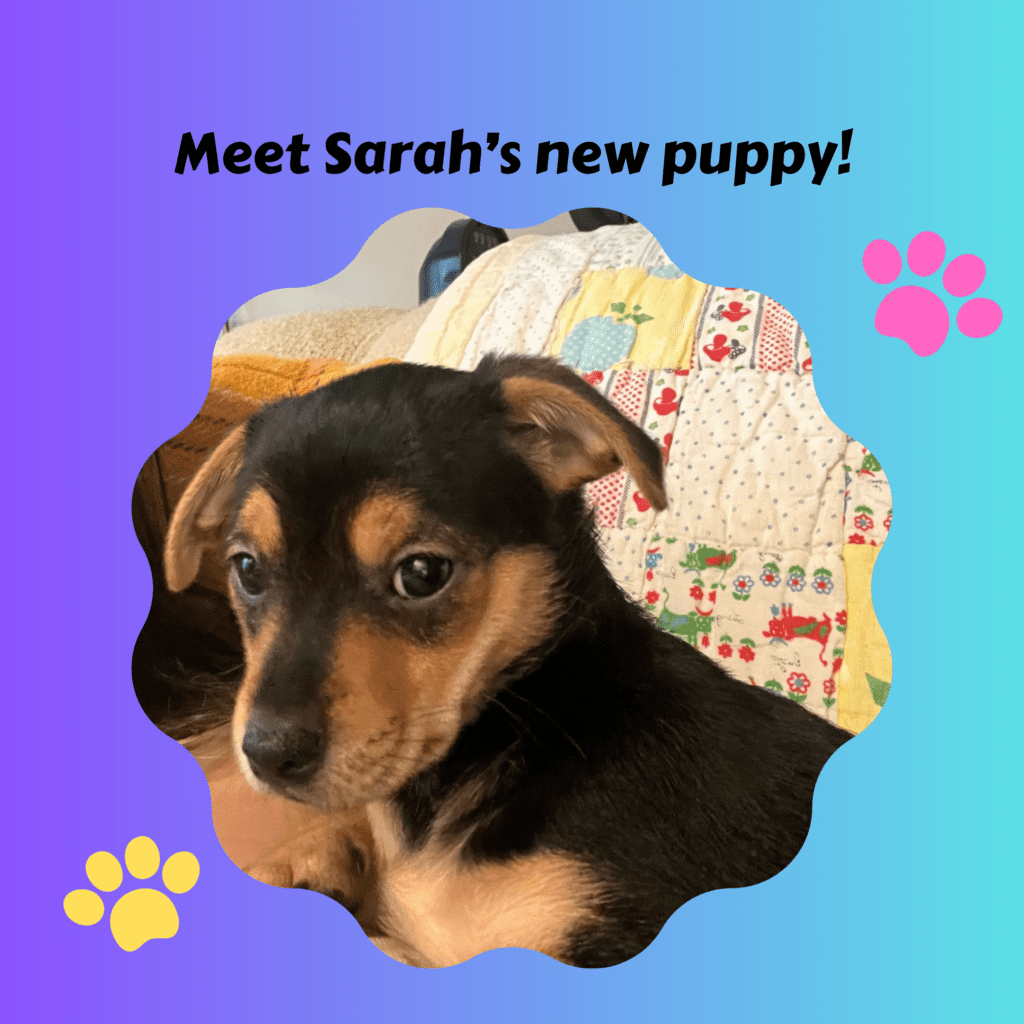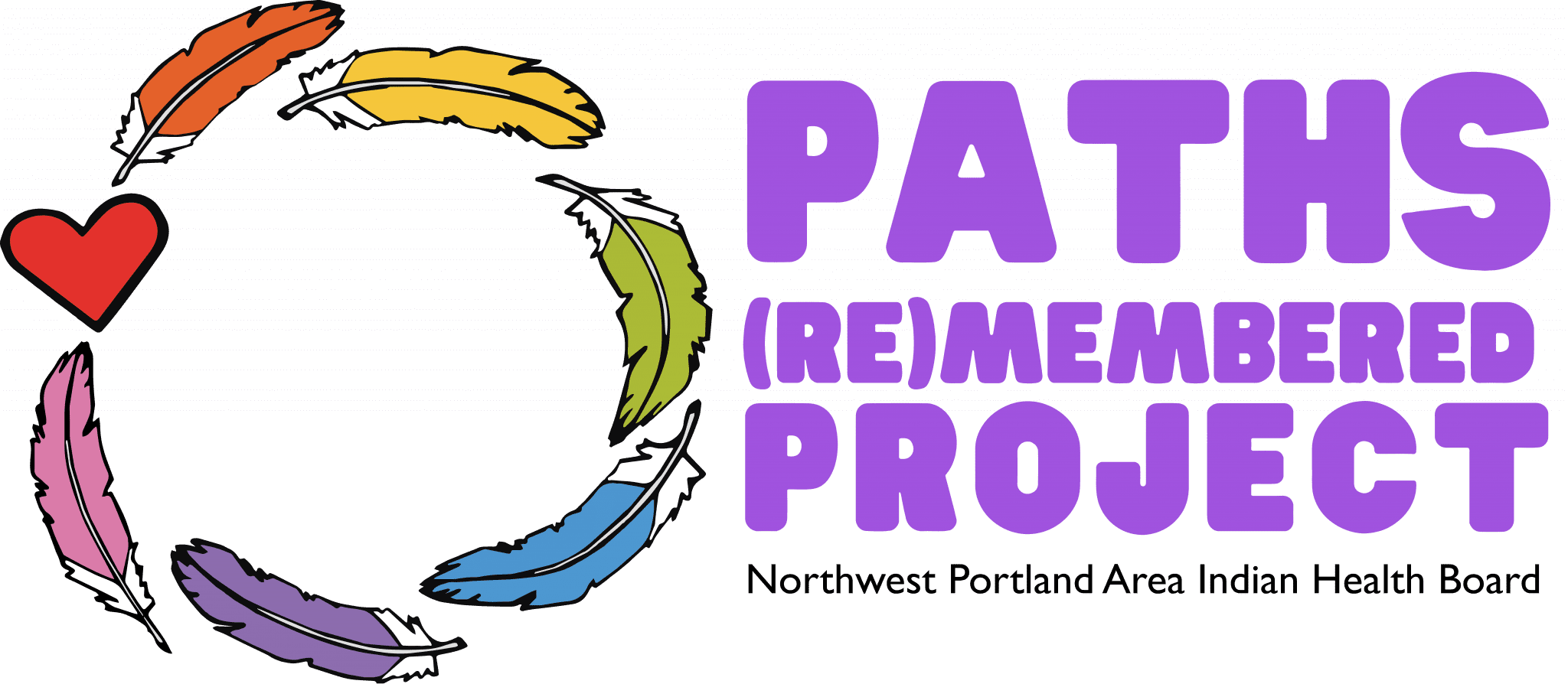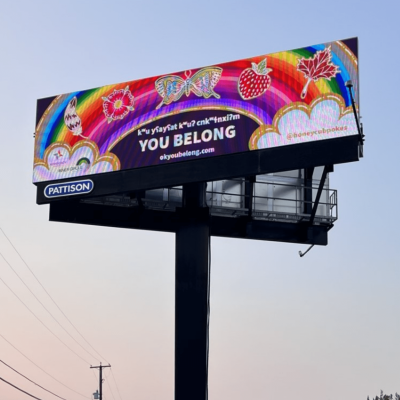This month, we spoke with Sarah Jones, creator of the You Belong billboard project.
Would you introduce yourself?
My name is Sarah Jones. I was born and raised in Vernon, British Columbia, which is a really small town about an hour from where I am now. My indigenous background is Anishinaabe from Shoal Lake 40 First Nation, Ontario. It’s about five hours from Winnipeg, across the country from where I’m living now. My grandma is full-blood Anishinaabe and a residential school survivor. After going through all of that, she decided she needed to leave. She took a plane to Merritt. There, she met my grandfather, and they had my mom. And that’s where I came in.
I grew up very separated from my culture. It’s only in the last three years that I’ve started to really look for connection to my culture, because I’ve felt I’m missing something. I started working at an indigenous nonprofit about a year ago. It was really eye opening in terms of, Oh. This is what it means to be an Indigenous person. I worked there for about a year and then I got burnt out and realized I needed to follow my dream of being an artist. I’ve been drawing ever since I was a kid, but my parents weren’t that supportive and I was never super committed to it. Reconnecting with my culture I realized, Okay. I think I was actually born to do this. I think my ancestors would be happy if I did this. So that’s how I got started. And the billboard project comes after.
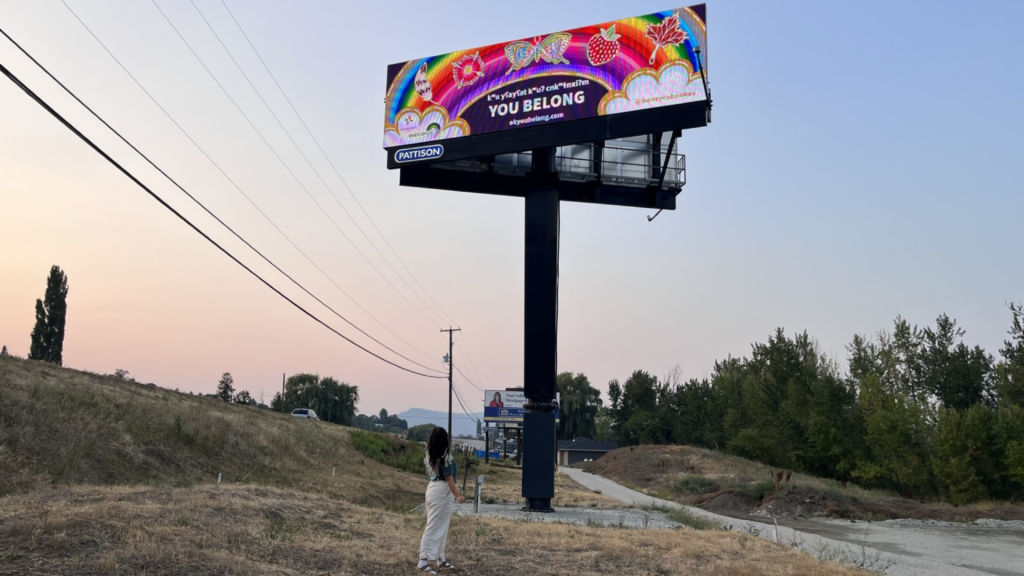
Sarah standing by the billboard, prominently displayed in Okanagan & Syilx territory in British Columbia.
What inspired you to create this billboard project specifically?
I’ve always been queer, but I only recently made the connection to being a Two Spirit person is. I hadn’t known what a Two Spirit person was, and I heard a description, and I realized, Oh. That’s me. Since then, I’ve been trying to connect with the local community where I’m living—the Okanagan people and the Syilx people. I live on their land.
It’s a very conservative area of Canada, and there was actually a billboard that went up in my community that was against LGBTQ+ people. It was a very hateful and offensive billboard, it actually got taken down because it was against the Canadian Human Rights Policy. Advocacy Canada, a nonprofit from Kelowna in the Okanagan territory decided we needed to address the message on that billboard. They put together a fundraiser and put out a call for Indigenous LGBTQ+ artists. I entered with my portfolio on a whim, and I got it!
We created a community focus group to figure out what we wanted the message on the billboard to be. We went with you belong, because we just wanted everybody to know that we are here. We exist. Whether you like it or not, you can’t do anything about it.
What was it like to be creating this billboard within community?
It was such good inspiration. When you’re doing commission work as an artist, you’re always having to apply someone else’s ideas to a project. But with this project, my own values matched what the group wanted perfectly. There was a bit of back and forth over the messaging, but everybody agreed that acceptance and love and kindness is the main theme.
One topic that was really important was the Syilx language, because the billboard is physically on Syilx land. So we partnered with the Syilx language house, which is a community language school. They’re working on teaching the Syilx language. We asked if there was a word or phrase we could use, and they suggested the phrase kʷu yʕayʕát kʷuʔ čn̓k̓ʷɬn̓xiʔm̓, which means We all join in together / We are all a part of it together.
Sarah (left) marching alongside others in front a printed banner of the billboard design.
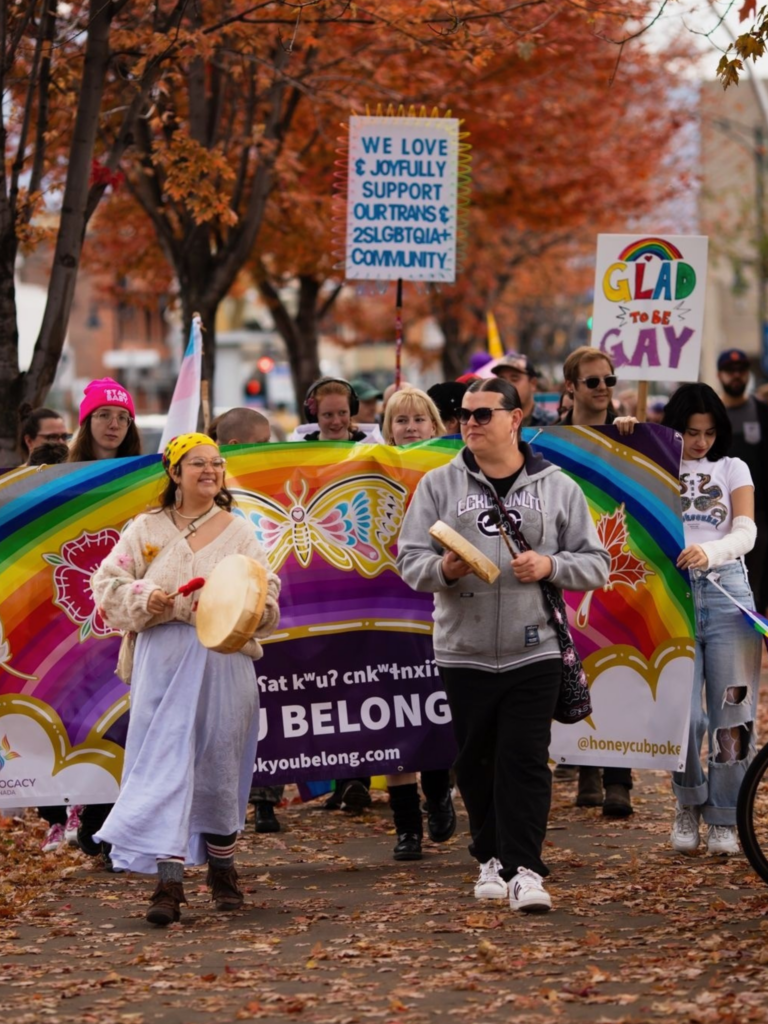
Could you speak a little bit to the design elements on the billboard—the butterfly and maple leaf and others?
I got inspiration from the land for many of them. The billboard always had a swallowtail. It was April or May as I created the project, butterfly season. This year, there were so many swallowtails. It was so beautiful. We wanted to represent that nature, the butterfly, but we decided to do the swallowtail in the trans colors to bring trans rights to the forefront. It was really important to both of us that “trans lives matter” be a central focus. The Alberta Rose comes from growing up in the Okanagan territory. It’s my favorite thing in the spring and summer when Alberta roses bloom.
The rest of the symbols came in as I was doing research into my ancestors’ regalia. I found the maple leaf and the strawberry in old black and white photos of my ancestors. I felt a connection to the people in those photos, felt inspired by them though I didn’t know them personally. I’ve also been trying to learn Anishinaabe a little bit, and in my language strawberry is o-day’min, which translates directly to heart berry. It’s a very sacred symbol in my culture.
In that sense, there’s symbols related to this land and also to my personal and cultural history. I think this gives the billboard some of its power—I really put my heart into it.
This is also partly your story of reconnection to culture. Could you talk about the relationships that you built through this and what that has meant for your journey of reconnecting?
Yes, I’m about 1700 kilometers away from my reservation but my mom and I took a trip back there for the first time in August. I got to meet my family and stand on the land and see the school that my grandma attended and meet my uncles. I was actually drawing the billboard design on the plane there, doing the finishing touches. So the project is very connected to my reconnecting journey. The majority of Indigenous people are urban, meaning they’re either in the city or away from their community. And one question I’ve been asking is how you can enter into a community and create meaningful connection. I did that by getting a job at a friendship center as the events coordinator. I was hosting the elders’ lunches, meeting the elders, noticing how they do a prayer and make a prayer plate before they eat. I kept thinking, Oh, this is how they do it. And then wondering how my people do it.
On my very first day at that job there was a powwow and everybody was wearing ribbon skirts. I didn’t know what a ribbon skirt was. I went to my mom and told her about these beautiful skirts the women make and why they make them. My mom looked at me and said, “Yeah, but that’s not our culture. Your grandma didn’t do that.” But it’s not true. We did. My mom just didn’t know. I had to tell her, We did. We did this too. We also have powwows. It’s sort of surprising, in a good way. We aren’t directly related, but in a sense the people here—these are my people too.
Find out more about the You Belong project at https://okyoubelong.com/. Find art and stickers by Sarah Jones at https://shawishmarket.com/ or on Instagram @honeycubpokes.
